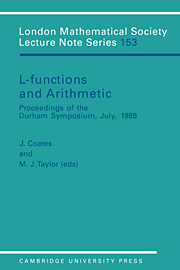Book contents
- Frontmatter
- Contents
- Preface
- Participants
- Lectures on automorphic L-functions
- Gauss sums and local constants for GL(N)
- L-functions and Galois modules
- Motivic p-adic L-functions
- The Beilinson conjectures
- Iwasawa theory for motives
- Kolyvagin's work for modular elliptic curves
- Index theory, potential theory, and the Riemann hypothesis
- Katz p-adic L-functions, congruence modules and deformation of Galois representations
- Kolyvagin's work on Shafarevich-Tate groups
- Arithmetic of diagonal quartic surfaces I
- On certain Artin L-Series
- The one-variable main conjecture for elliptic curves with complex multiplication
- Remarks on special values of L-functions
Lectures on automorphic L-functions
Published online by Cambridge University Press: 18 December 2009
- Frontmatter
- Contents
- Preface
- Participants
- Lectures on automorphic L-functions
- Gauss sums and local constants for GL(N)
- L-functions and Galois modules
- Motivic p-adic L-functions
- The Beilinson conjectures
- Iwasawa theory for motives
- Kolyvagin's work for modular elliptic curves
- Index theory, potential theory, and the Riemann hypothesis
- Katz p-adic L-functions, congruence modules and deformation of Galois representations
- Kolyvagin's work on Shafarevich-Tate groups
- Arithmetic of diagonal quartic surfaces I
- On certain Artin L-Series
- The one-variable main conjecture for elliptic curves with complex multiplication
- Remarks on special values of L-functions
Summary
PREFACE
This article follows the format of five lectures that we gave on automorphic L-functions. The lectures were intended to be a brief introduction for number theorists to some of the main ideas in the subject. Three of the lectures concerned the general properties of automorphic L-functions, with particular reference to questions of spectral decomposition. We have grouped these together as Part I. While many of the expected properties of automorphic L-functions remain conjectural, a significant number have now been established. The remaining two lectures were focused on the techniques which have been used to establish such properties. These lectures form Part II of the article.
The first lecture (§I.1) is on the standard L-functions for GLn. Much of this material is familiar and can be used to motivate what follows. In §I.2 we discuss general automorphic L-functions, and various questions that center around the fundamental principle of functoriality. The third lecture (§I.3) is devoted to the spectral decomposition of L2(G(F) \ G(A)). Here we describe a conjectural classification of the spectrum in terms of tempered representations. This amounts to a quantitative explanation for the failure of the general analogue of Ramanujan's conjecture.
There are three principal techniques that we discuss in Part II. The lecture §II.1 is concerned with the trace formula approach and the method of zeta-integrals; it gives only a skeletal treatment of the subject.
- Type
- Chapter
- Information
- L-Functions and Arithmetic , pp. 1 - 60Publisher: Cambridge University PressPrint publication year: 1991
- 3
- Cited by



